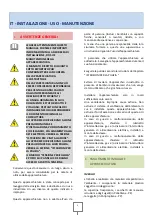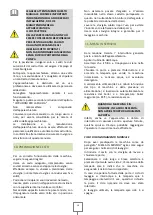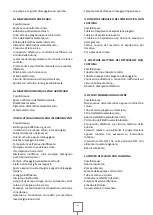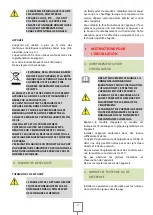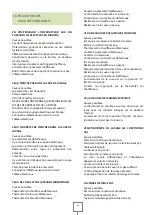
19
8.
ADJUSTMENTS AND CHECKS
The following adjustment and setting operations
may be carried exclusively by qualified and
authorised personnel, paying the utmost care and
attention, and taking all precautions in the event
that safety features are bypassed.
The warranty does not cover damages resulting
from improper use of the dispenser (s) or incorrect
manual feed.
Adjustments must be made with the appliance hot
and correct amount of washing product.
Type and dosage of detergent and rinse agent are
crucial in affecting the appliance’s performance and
service life.
Use only liquid products for industrial washing with
antifoaming agents.
The temperature inside the bowl is set at 55/60°C.
This temperature favours the correct use of the
chemical characteristics of all industrial detergents.
The temperature of the boiler is set at 87-90°C.
This value allows the rinse water temperature to be
optimized throughout the cycle.
It is advisable not to change this parameter.
RINSE AID DISPENSER
The appliance is equipped with a fully automatic
rinse aid dispenser.
Before starting the appliance make sure that the
rinse aid suction tublet is inserted to its container.
During the manufacturing process the dispenser is
calibrated for maximum opening and must be then
adjusted according to the water hardness.
Before setting the right amount of surfactant to be
used, it is advisable to carry out a specific test to
determine the degree of water hardness.
If the hardness of the water is greater than 15°F.
(French degrees), we advise to install a decalcifier
upstream from the supply solenoid valve of the
machine.
Calibration:
Turn
the
adjustment
screw
anticlockwise to increase the capacity and clockwise
to decrease it. A perfect dosage is obtained by
turning the adjustment screw by approximately 90
degrees.
LOADING THE DETERGENT
USE ONLY SPECIFIC ANTI-FOAM
DETERGENTS IN THE APPROPRIATE
DOSES.
Pour the required amount of detergent into the
dishwasher by following the instructions provided
by the manufacturer.
If powder detergent is used make sure that it is
evenly distributed in the bowl and does not deposit
on one single area in order to avoid the formation
of dark stains at the bottom; shake the water.
DISPENSER FOR LIQUID DETERGENT (OPTIONAL)
We recommend installing an automatic detergent
dispenser.
Follow the manufacturer's instructions carefully.
The amount of detergent poured into the bowl
depends on the amount of water consumed by the
machine during each rinse cycle.
Before adjusting the detergent dispenser (optional),
this and the corresponding small supply pipe must
be filled as follows:
- Supply voltage to the machine.
-
The dispenser is connected in parallel with the
load/rinse solenoid valve.
-
Do not insert the overflow in the drain hole and run
the water until the small transparent plastic pipe
and the dispenser are filled.
-
Check the detergent concentration and the supply
water hardness by referring to the product data
sheet before adjusting the dispenser.
HOW TO REGULATE THE DETERGENT DISPENSER
By fully turning the timer anticlockwise the pump is
always off, whereas by turning fully it clockwise the
pump is always on.
The intermediate settings of interval/operation are
exemplified in the diagram below:
Since the control is parallel to the load/rinse
solenoid valve, when the machine is filled with
water, the dispenser adds the detergent according
to the amount established by the manufacturer.
When the rinse cycle starts, the load/rinse solenoid
valve allows the dispenser to replenish the
detergent in the bowl.
The amount of detergent is right when the crockery
is free from any food residues at the end of the
wash cycle.
An excessive amount of detergent can give rise to
the build-up of foam in the bowl and leave white
streaks on the crockery.
Insert the overflow in its housing and carry out
some trial cycles.
Perfect wash results can be guaranteed by gradual
setting.
FUNCTIONAL CHECKS
Before operating the machine it is appropriate to
follow the testing procedure below:
Summary of Contents for HT 50 Series
Page 60: ...60 RU I o...
Page 61: ...61 1 PE PP 90 2 II 3...
Page 62: ...62 IP X4 0 C 4 5 6 10 7 III H05 RN F...
Page 63: ...63 2 2 5 20 100 C 1 8 55 60 C...
Page 64: ...64 87 90 C 15 F...
Page 65: ...65 1 2 8 5x8 1 III 9 10...
Page 66: ...66 11 2 1 4 85 C 6 2 4 4 1 4 2 3 4 3 2 20...
Page 67: ...67 4 9 60 8 2 7 1 7 8 8 1 20 8 N B 40 F 12 12 60 IV...
Page 68: ...68 13 V 14...
Page 69: ...69 15 16 O...
Page 70: ...70...
Page 71: ...71 17 18 2 3 a 19...
Page 72: ...72 VI PANNELLO DI CONTROLLO CONTROL PANELS PANNEAU DE CONTROLE PANEL DE CONTROL SCHALTBRETT...

